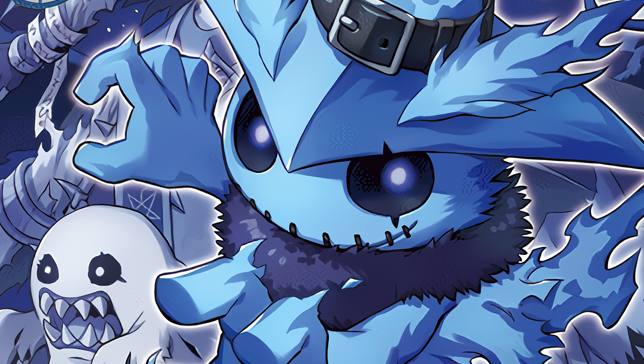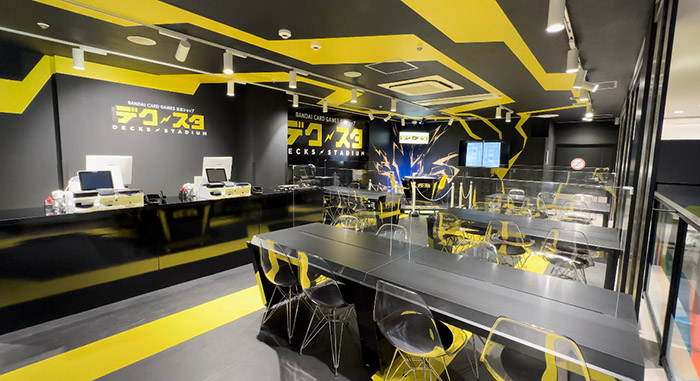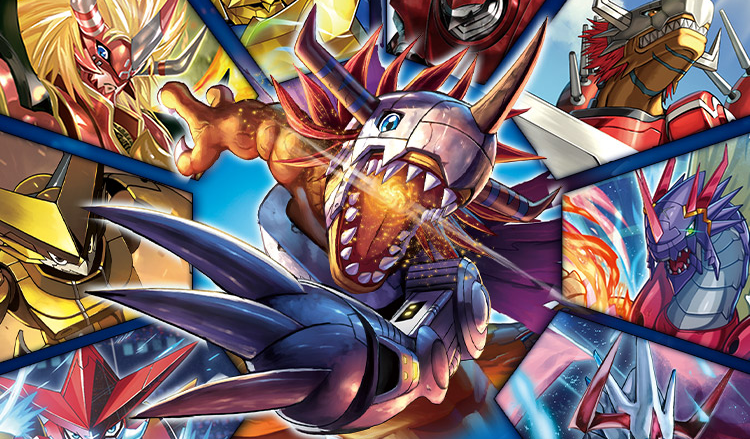The Digimon TCG’s BT20 set, “Over the X” as of this post has recently released in Asia (it’ll be out in the West at the end of the month), and with it are a whole new host of cards and decks to explore. For me there were lots of interesting front-runners that I wanted to try out first, most notably Jesmon, ACCEL Chaosmon, and updated support for Zephagamon.
And so when the set finally did come out, and I finally got over my collecting and organizing frenzy that was release weekend, I set out to build pretty much any deck my brain could conceive of, or at least the base versions ( Part of being a content creator, gotta know your stuff. YouTube commenters stay on my ass as soon as I so much as even pronounce something strange 🤣). A little look into my process when a new set releases, I typically build up everything and then start testing with decks that I like the most, pitting them up first against other decks from the set. This way I can learn 2 decks at once. Then once that’s done, I move onto the decks that I think are fun or interesting and and pit them against older, already established decks.
So again, back to BT20, I built out the base version of Necromon using all of it’s themed cards, which nowadays in the game basically leaves you about 10-12 open slots for the deck, which you can usually fill with some good generic cards like Ukkomon, trainings, or memory boosts (This is actually something I really like about new decks in the game right now, as it’s super beginner friendly. If I find the time, maybe I can expand on it in a different post in the future). So I pop those in and then start playing it against some of the other decks. For the unfamiliar, this deck focuses on “On Deletion” effects alongside the new “Execute” keyword effect that says at the end of your turn, the Digimon with the “Execute” effect can attack and at the end of the attack delete the Digimon. Through the effect, it can also attack unsuspended Digimon. After like 3 games, I realized that, this deck actually seemed really interesting.




In true purple style, there are some really fun combos you can do such as using “Execute” to attack then delete your Digimon to get back memory thanks to some of the inheritance effects. And while you might be worried about losing your Digimon stack, some cards like the Phantomon or Necromon, can actually replay a Lv4 or Lv5 when they are deleted, so you’re not left with nothing. You can then combo this with the Violet Inboots Tamer to immediately evolve the ghost you replayed at cost -2. So you could start your turn with a Necromon, and then finish the turn with another Necromon on the board. There were also other side effects that seemed interesting like when your Digimon is deleted you can trash a card and delete an opponent’s Lv4 or lower Digimon or the ability to give one of your Digimon “Retaliation” for the turn.



Anyway, I digress, after those aforementioned 3 games, I laid the deck back out, and then slotted in some smarter choices to really maximize it’s ability to get resources when Digimon are deleted. Cards like “Analog Youth”, “Nidhoggmon”, and “Ginkakumon Promote” to name a few.



I then tried it out a few more times, and I came to the ACCEL Chaosmon matchup. For the folks who don’t know. ACCEL Chaosmon is a really cheap deck (in every sense of the word btw) that sees it build it’s boss monster “Chaosmon” who when deleted, Partitions into twoLv6’s, both of which who have particularly nasty On Play effects like resting all of your opponent’s Digimon, or De-Digivolving an opponent’s Digimon 2 stages and then giving something -5000 DP. This means that when you try to kill Chaosmon, he can revenge De-Digivolve you immediately (making him, for the most part, the ACE murder). I got to a point during one of my practice games where the opponent had their Chaosmon up, but I managed to digivolve up to a Necromon with Retaliation, passing the memory over to 1 on my opponent’s side, and suddenly a logic puzzle laid before me. “Is there a way I can play around the Chaosmon’s partition and get the upper hand?” I asked myself.



I thought to myself, if I use “Execute” to attack and then lose the battle (Necromon: 12k DP vs. Chaosmon 15k DP), I would play a Lv4 and Lv5 Digimon on the board, Gain +1 Memory (tipping the memory to 0 so I could keep my turn), “Retaliation” would resolve, deleting the Chaosmon, and then both of Chaosmon’s Lv6’s would Partition onto the board, resting my Digimon, and giving my Lv4 Digimon -5000 DP, destroying it. (The De-Digivolve doesn’t do anything because my cards would have no sources).
I wracked my brain for a second thinking, “Is this really the best I can do?” The next turn they would just create another Chaosmon, and the attack would have kind of been for naught. After thinking about it for a few more minutes, I then did what I do in these kinds of situations, consult people who actually read the bottom text on cards. I headed over to the “rules-questions” thread in the Digimon TCG discord, and asked about my situation. I also made sure to ask when did Retaliation trigger and resolve?
The bottom-text readers hit me with some eye-opening info. Retaliation as an effect triggers at the same time any “On-Deletion” effect would trigger, and because in Digimon when multiple effects trigger at the same time you can resolve them in any order.
So let’s talk first about this whole trigger and resolving business for a second. If you play the game (which honestly, if you’re this deep into the post and you don’t, I’m glad my writing captivated you to get this far. Now go buy a starter-deck). You probably have a vague sense that you activate effects and then if effects activate at the same time, you can use them in any order, with turn player getting to use theirs first. This notion of the effect “activating” is what the game considers the effect as “triggering”. So when effects trigger at the same time, they basically create a sort of stack (I find it helpful to imagine it like Jenga, where each block represents a single effect, but where you can only take blocks from the top, and one level of the stack can have multiple blocks).

And then once stacks have been built up, you essentially “use” that effect or more aptly put “resolve” the effect (Mentally you can think of this as taking the block off of the stack). What’s really important to know is that when resolving effects, sometimes that may trigger other effects, and when that happens, those other effects need to be resolved first, before you can continue. You can think of this as placing a block on top of the stack that you’re pulling from, and because we can only take blocks from the top of the stack, before we can go back to the other blocks from the now lower level, we have to take out the new blocks from the top-most level first.
So what does this Jenga-ass analogy and Retaliation triggering at the same time as the On-Deletion effects actually mean? Long-story short, with a bit of brain power, as the Necromon player, I can create a scenario that is only good for me. So it goes like this:
- Necromon [12k DP] attacks Chaosmon [15k DP]
- Necromon loses the battle, and all of cards are put into the trash.
- [On Deletion: Memory +1, On Deletion: Play Lv5 from Trash, Retaliation, On Deletion: Play Lv4 from Trash] all trigger at the same time. Each of these is a block placed at the same level at the top of the stack.

- Take the Retaliation block from the stack, and resolve it, deleting Chaosmon
- When Chaosmon would be deleted, it’s Partition effect triggers. Put this as a new block on the top of the stack.

- Play the two Lv6s as per the Partition, taking the Partition block off of the stack.
- [BanchoLeomon’s On Play: De-Digivolve 2 and -5k DP, Valdourmon’s On Play: Rest all opponent’s Digimon and give 1 of your Digimon +3k DP] both trigger at the same time. Both of these are placed as blocks at the same level at the top of the stack. (They triggered at the same time and can be resolved in any order the controlling player choses).

- Varudorumon’s On Play resolves, but I have no board to rest, so it just gives +3k DP to itself. Take that block off of the top of the stack.
- BanchoLeomon’s On Play resolves, but I have no board to De-Digivolve, and no Digimon to give -5k DP to, so nothing happens. Take that block off of the top of the stack.
- With all of the opponent’s blocks removed from the top of the stack, I can now go back to resolving the rest of my On Deletion effects which are now the top stack.

- Gain +1 memory, take that block off of the stack.
- Take the On Deletion: Play Lv5 from Trash block off of the stack and resolve it.
- Take the On Deletion: Play Lv4 from Trash block off of the stack and resolve it.
Sorry I know that full explanation was a bit long-winded, but I did it for the sake of showing the full set of effects and how Digimon’s stack-based effect system works. I think it’s also a useful example to show you the importance of knowing when your effects, especially keyword effects like Retaliation, trigger and can be resolved. Do you know when other effects like Fortitude, Alliance, or Raid, trigger and resolve? It could mean the difference between winning and losing a game. 🤔
As an extra little aside, I realized that the deck also has MetalPhantomon, with the inheritance effect of “On Deletion: De-Digivolve 1 on an opponent’s Digimon”. If I had him in the stack, I could have attacked the Chaosmon with my Necromon like before, died because of the battle, and then activated the MetalPhantomon’s On Deletion effect to De-Digivolve the Chaosmon, and then use Retaliation to delete it, preventing the Chaosmon’s Partition all together. Digimon’s effect system is pretty cool eh?

So that about wraps things up here. I thought this was a really interesting subject, but also I think it’s a great and simple way to teach newer players how to think about the game, and their effects. If you know someone who would benefit from this, please feel free to share it with them. If you’re one of the rare bottom-text readers out there, and already knew this, then I hope it just served as a good refresher. Also, I hope that reading this has also piqued your interest in the new Liberator Ghost deck featuring Necromon from BT20. It’s VERY fun, and I’ve had a good time trying it out and messing with it. Also, don’t ask me for a decklist. Believe in yourself.
Finally, just want to give a big thank you to all of the folks who in the rules-question channel of the Digimon TCG 2020 discord including Emiya, nmotsch789, Raizor, and TFR who helped to answer my questions and helped me through my understanding of the events that inspired this post. Also thanks for reading all the way to the end. If you’d like to support me and see more posts like these, consider supporting me by becoming a YouTube member on my YouTube channel. You’ll also get some cool perks and bonuses there like early access to my content, and the ability to vote on the kind of content you’d like to see in videos and these kinds of articles.





